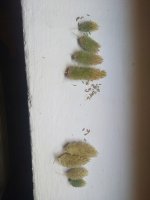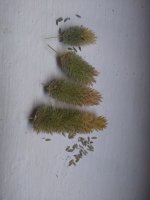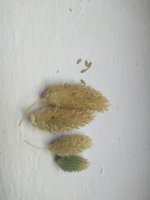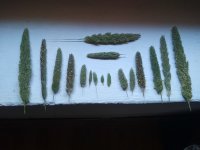What's PNW?
-
Members of the previous forum can retrieve their temporary password here, (login and check your PM).
You are using an out of date browser. It may not display this or other websites correctly.
You should upgrade or use an alternative browser.
You should upgrade or use an alternative browser.
Phalaris Project
- Thread starter dithyramb
- Start date
Migrated topic.
Tony6Strings
Esteemed member
Pacific Northwest.
I guess my answer lies in my question  İ live in the Mediterranean.
İ live in the Mediterranean.
 İ live in the Mediterranean.
İ live in the Mediterranean.My latest understanding is that 5 Meo DMT, hordenine, and N Methyl Tyramine are all blood pressure raisers with a contraindication with maoi after a certain level of dose. They probably should not be in an ayahuasca analogue beyond trace amounts.
Combining my research and experiences, I speculat that 5 MeO DMT adds a coldness, alienness, and unconsciousness to the experience. It is the opposite of DMT in a way - an experience of a void or nothingness as opposed to the infinite content of DMT. I am in the camp that believes 5 MeO DMT occurs in chaliponga in trace amounts, even if not detected easily for some reason, and it is at least a factor in it's coldness and less visualness (it is said that the occurrence of 5 MeO DMT diminishes the visual effect of DMT). The ratio appears to possibly be much higher in various phalaris species, sometimes being the dominant or even sole tryptamine. I am seeking content, a healing journey. The brachystachys appears to fulfill this need.
It is said that gramine is not soluble in water and I am not concerned about it.
Combining my research and experiences, I speculat that 5 MeO DMT adds a coldness, alienness, and unconsciousness to the experience. It is the opposite of DMT in a way - an experience of a void or nothingness as opposed to the infinite content of DMT. I am in the camp that believes 5 MeO DMT occurs in chaliponga in trace amounts, even if not detected easily for some reason, and it is at least a factor in it's coldness and less visualness (it is said that the occurrence of 5 MeO DMT diminishes the visual effect of DMT). The ratio appears to possibly be much higher in various phalaris species, sometimes being the dominant or even sole tryptamine. I am seeking content, a healing journey. The brachystachys appears to fulfill this need.
It is said that gramine is not soluble in water and I am not concerned about it.
I've been camping in isolation to apprentice to the grass, and I just had a surprise experience.
I was going to do a proper ceremony with fire with the "truncata" but in the last moment I found out that the heat had turned the brew into a tasty wine. Well then, I decided to drink the latest aquatica in the most recent picture instead, which I had brewed more recently (let's call it "aquatica 4").
I didn't really expect anything, but behold, I was blown away. 25g fresh. No side effects. Sweet Divine ecstasy. Orgasmic. I feel I am meeting a different medicine and I am at a loss in finding proper words to express this experience. I was a bit prejudiced against 5 MeO DMT before. Now I appreciate it as part of the tryptamine soup that this plant is. DMT was a significant part of the soup also, Divine laser beams from Heaven, and a lot of visual activity going on (with an oil painting like texture).
5 MeO DMT actually felt safe and I did not feel any raise in blood pressure or stimulation. There was probably an absence or minimal amount of tyramines (hordenine etc). The blades were collected from four separate clumps growing under the shade of the same tree. Was the benignness due to growing under shade, or due to strain, or both, I don't know. Shade is said to increase tryptamines, do we know what it does to tyramines? Also, how likely is it that this grass sown from seed will carry roughly the same medicine? Perhaps forcing it to be solely DMT requires cloning, and otherwise aquatica is roughly consistent (in contrast to arundinacea)?
Of course this plant is much more than just a tryptamine soup. The total synergy, the whole spirit is a unique "Buddha Medicine."
Very healing. I am not sure if it can be an amplified voice for rue as it seems to gravitate to an ineffable ecstasy. Even though the experience was strong, I felt a breakthrough awaiting if I drank more. I did not drink more so that my friend who owns the garden from which I harvested it has enough for a taste. Rue was speaking behind the curtains. Would it be completely wiped out with a higher dose of this aquatica, or would they merge and speak/narrate as one I don't know.
But this is too precious to overlook as a medicine in its own right. Thank you, delicious, Divine spirit food

I was going to do a proper ceremony with fire with the "truncata" but in the last moment I found out that the heat had turned the brew into a tasty wine. Well then, I decided to drink the latest aquatica in the most recent picture instead, which I had brewed more recently (let's call it "aquatica 4").
I didn't really expect anything, but behold, I was blown away. 25g fresh. No side effects. Sweet Divine ecstasy. Orgasmic. I feel I am meeting a different medicine and I am at a loss in finding proper words to express this experience. I was a bit prejudiced against 5 MeO DMT before. Now I appreciate it as part of the tryptamine soup that this plant is. DMT was a significant part of the soup also, Divine laser beams from Heaven, and a lot of visual activity going on (with an oil painting like texture).
5 MeO DMT actually felt safe and I did not feel any raise in blood pressure or stimulation. There was probably an absence or minimal amount of tyramines (hordenine etc). The blades were collected from four separate clumps growing under the shade of the same tree. Was the benignness due to growing under shade, or due to strain, or both, I don't know. Shade is said to increase tryptamines, do we know what it does to tyramines? Also, how likely is it that this grass sown from seed will carry roughly the same medicine? Perhaps forcing it to be solely DMT requires cloning, and otherwise aquatica is roughly consistent (in contrast to arundinacea)?
Of course this plant is much more than just a tryptamine soup. The total synergy, the whole spirit is a unique "Buddha Medicine."
Very healing. I am not sure if it can be an amplified voice for rue as it seems to gravitate to an ineffable ecstasy. Even though the experience was strong, I felt a breakthrough awaiting if I drank more. I did not drink more so that my friend who owns the garden from which I harvested it has enough for a taste. Rue was speaking behind the curtains. Would it be completely wiped out with a higher dose of this aquatica, or would they merge and speak/narrate as one I don't know.
But this is too precious to overlook as a medicine in its own right. Thank you, delicious, Divine spirit food


It is also noteworthy how different the spirits of aquatica 1 and aquatica 4 are, apart from th difference in physical effects - disturbing blood pressure rise and stimulation vs comfortable, benign feel. The former appeared to me as a no BS, stern teacher whereas the latter is like euphoric Buddha joy. Once again, if a way is found of how to reduce the tyramine production, the former might have an intrinsic practical value worth further pursuing as well.
A little research and I found out that DMT and 5 MeO DMT actually have tolerances for about 2 hours. This means that the ingesting a new plant gradually in incremental doses might not be an efficacious approach. Some of my experiences make more sense now, and it appears on average the grasses that I have come upon are very potent.
My last aquatica experience interestingly reminded me of Jamie's report - a powerful "empathogenism" and Buddha consciousness. The unique medicine of aquatica... Highly refined celestial energy. The plant knows in what way to blend molecules and this goes much beyond our understanding of individual psychedelic molecules. Every component, including the tryptamines and beta carbolines surely play a role. I did sense beta carbolines also, probably 2MTHBC as a similar smooth crystal clarity to that of Russian Olive was present.
Right now I an brewing up blades of the huge paradoxa in the recent photo. A single clump gave 90g fresh blades (and vast land is completely covered with this grass, most are drying out but there are some younger ones popping up also) Hey chimp z. I know you are fond of paradoxa, but I am not clear whether you have tried it with rue with success. Honestly, my first experience with it, with grass collected from a different area was very loveless, meaningless, and dissociative. How would you describe your experiences?
Right now I an brewing up blades of the huge paradoxa in the recent photo. A single clump gave 90g fresh blades (and vast land is completely covered with this grass, most are drying out but there are some younger ones popping up also) Hey chimp z. I know you are fond of paradoxa, but I am not clear whether you have tried it with rue with success. Honestly, my first experience with it, with grass collected from a different area was very loveless, meaningless, and dissociative. How would you describe your experiences?
Mostly smoked Paradoxa and it "blasted off" 3 people extremely far the first time I extracted it.
So I think there was either DMT or 5-meo tryptamines in it too. It was definitely very visual
and pulled the body along for the ride. Visions akin to riding on a rollercoaster through a tunnel
with animals and weird figures like jokers/jesters making the ride take sharp turns and unexpected maneuvers
when they would appear. The "entities" were dancing almost provocatively like "you want some of this" .
When I first worked with Paradoxa years ago it was harvested around April-May along
a sandy river.
No really memorable experiences drinking it.
With many patches of grass I would have successful heavy trips some years
and mild effects other years. Even week to week or month to month.
Ya it sounds like you have a Phalaris wonderland around you.
So I think there was either DMT or 5-meo tryptamines in it too. It was definitely very visual
and pulled the body along for the ride. Visions akin to riding on a rollercoaster through a tunnel
with animals and weird figures like jokers/jesters making the ride take sharp turns and unexpected maneuvers
when they would appear. The "entities" were dancing almost provocatively like "you want some of this" .
When I first worked with Paradoxa years ago it was harvested around April-May along
a sandy river.
No really memorable experiences drinking it.
With many patches of grass I would have successful heavy trips some years
and mild effects other years. Even week to week or month to month.
Ya it sounds like you have a Phalaris wonderland around you.
Thanks Chimp z. İt appears your experience confirms a certain dark nature to this plant. Very interesting nevertheless!
I have found out that the sterile lemma on the seeds of brachystachys really are characteristic and a defining feature of this species.
I have found brachystachys again; it is morphologically the same as the previous ones - really tall with huge flowers. When I started cultivating it myself, it did not grow so high and it appears the exaggerated growth is triggered by trying to reach sunlight among crowded, tall bushes. I will post pictures of the ones in my garden.
I feel it is very promising, with two humble meetings so far... In contrast to the cosmic aquatica, a deep journey of healing...
I have found brachystachys again; it is morphologically the same as the previous ones - really tall with huge flowers. When I started cultivating it myself, it did not grow so high and it appears the exaggerated growth is triggered by trying to reach sunlight among crowded, tall bushes. I will post pictures of the ones in my garden.
I feel it is very promising, with two humble meetings so far... In contrast to the cosmic aquatica, a deep journey of healing...
Does anybody know the seed dormancy period of P. brachystachys? I had planted many seeds directly from live plants about a month ago but only two have germinated so far.
I am thinking of sprouting other seeds before planting. I wonder if I should wait some time before trying it.
I am thinking of sprouting other seeds before planting. I wonder if I should wait some time before trying it.
Datapoint: on all (two) occasions of drinking aquatica with rue as a second serving (after a dose/experience of rue and other phalaris), I got symptoms of what I would call posioning. This even happened with the seemingly benign "aquatica 4." Luckily this time it did not feel fatal, but somethings were seriously off. The tryptamine dose felt very strong at 17g fresh, there were crazy visuals. There was increased, intensified heart rate. And there was an unconsciousness... I am not sure anymore about what in the plant is causing these "side effects" but for me, evidently there are toxins in this plant which become intolerable with excessive maoi. My interest to this plant is slowly waning. My eyes are now on the brachystachys seedlings growing steadily from seeds of plants İ found in the wild.
I seek healing, love, connection. The "truncata" delivers this to me even if without tryptamines. And of course, the goddess rue, my sacred teacher medicine.
I seek healing, love, connection. The "truncata" delivers this to me even if without tryptamines. And of course, the goddess rue, my sacred teacher medicine.
I have confirmed that the "truncata" is indeed Phalaris truncata (thanks for the hint, Chimp z!). I am in love with it even without getting a tryptamine blast. It has a very loving intelligence and speaks. These are the qualities I am foremost seeking, and a strong tryptamine effect l welcome on top of that. İt is noted by festi and samorini that truncata from France has detectable amounts of DMT and trace amounts of MMT (NMT), 5 MeO DMT, and bufotenin. I would love to either discover a high alkaloid strain, or find a secret to boost it's DMT content to sufficient levels.
It is interesting how in '"Ayahuasca-like" effects*obtained with Italian plants' by Festi and Samorini, there is an experience report with rue and the AQ1 strain of Aquatica which invloved the classic side effects from high dose Aquatica which I get, including unconsciousness and tremors. Aquatica cannot replace traditional admixtures in the formation of an ayahuasca analogue in my experience, it is a unique experience unto itself, and the side effects seem to encompass even supposedly pure DMT strains...
Hey dithyramb, this is a great thread.. have not gotten through all of it but am really enjoying your passionate accounts of this underappreciated teacher ... the seed heads of these plants are magnificent and are enough to draw the casual observer in for a closer look. I think this aspect of being "drawn" to the plant or "called" if you will is actually a really important part of the tryptamine journey. Certainly for me it provided a deeper context to experience that the extracts yield .. and I can feel from your posts that this is the case for you too 
I was wondering whether anyone could shine light on why the grass doesn't seem to work well when dried?
I was wondering whether anyone could shine light on why the grass doesn't seem to work well when dried?
Thank you dithyramb and others who help for your efforts - very much appreciated.
I am following and reading your thread for quite some time now and enjoying the information.
I've been interested in Phalaris species but never went and try to find them. Your thread is an inspiration to do that and even more so as I'm also close the mediterranean as you are. I posted some photos of what I think is P. arundinacea in Phalaris ID thread. Supposedly there should also be other species of Phalaris growing around here which I am very happy to go look for.
Thanks a lot and keep up the good work!


I am following and reading your thread for quite some time now and enjoying the information.
I've been interested in Phalaris species but never went and try to find them. Your thread is an inspiration to do that and even more so as I'm also close the mediterranean as you are. I posted some photos of what I think is P. arundinacea in Phalaris ID thread. Supposedly there should also be other species of Phalaris growing around here which I am very happy to go look for.
Thanks a lot and keep up the good work!
Hi acacian! Thank you for chiming. Do you have experience with grass? I will write in your recent thread 
Hi Triglav! Thanks for being here. I think you missed the season for most phalaris species this year, but I hope you make progress in this quest if this is what you wish.
It's a great feeling when one is able to share their passion with others
So far (within 10 days) only three brachystachys seeds have sprouted out of possibly hundreds which I have laid for sprouting in cotton. I guess this is the seed dormancy phenomenon of fresh seeds... Patience is always necessary.
Hi Triglav! Thanks for being here. I think you missed the season for most phalaris species this year, but I hope you make progress in this quest if this is what you wish.
It's a great feeling when one is able to share their passion with others

So far (within 10 days) only three brachystachys seeds have sprouted out of possibly hundreds which I have laid for sprouting in cotton. I guess this is the seed dormancy phenomenon of fresh seeds... Patience is always necessary.
I thought I came upon a huge brachystachys clump today, but upon inspecting the seeds, I realized that it is canariensis. This is my first canariensis find. Right in front of a veterinary clinic, that makes sense.
Photo 1 - Brachystachys flowers and seeds next to canariensis flowers and seeds.
Photo 2 - brachystachys
Photo 3 - canariensis
The canariensis seeds are larger, fatter, more shiny, and with a different sterile lemma structure.
(I apologize for the shittiness of my camera...)
Canariensis is the domesticated form of brachystachys. It is obvious that it was cultivated for the seeds. But what about the tryptamines? And what about other medicinal properties? Attached is a paper on some of the medicinal properties of P. canariensis. These properties are most likely shared by it's wild ancestor brachystachys.
I actually cultivated P. canariensis as a child, trying to emulate a natural environment in a terrarium with grass from birdseed for my tarantulas, which I had also caught from the wild
I have a hypothesis that the 6 chromosomed clade (brachystachys, canariensis, truncata) are the truly workable rue admixtures. We'll see if it's true in time. All these species have seeds with large, distinctive sterile lemmas.
Photo 1 - Brachystachys flowers and seeds next to canariensis flowers and seeds.
Photo 2 - brachystachys
Photo 3 - canariensis
The canariensis seeds are larger, fatter, more shiny, and with a different sterile lemma structure.
(I apologize for the shittiness of my camera...)
Canariensis is the domesticated form of brachystachys. It is obvious that it was cultivated for the seeds. But what about the tryptamines? And what about other medicinal properties? Attached is a paper on some of the medicinal properties of P. canariensis. These properties are most likely shared by it's wild ancestor brachystachys.
I actually cultivated P. canariensis as a child, trying to emulate a natural environment in a terrarium with grass from birdseed for my tarantulas, which I had also caught from the wild
I have a hypothesis that the 6 chromosomed clade (brachystachys, canariensis, truncata) are the truly workable rue admixtures. We'll see if it's true in time. All these species have seeds with large, distinctive sterile lemmas.
Attachments
Evidently having a strong, deep rhizome structure, P. truncata continues to thrive and remain green so far during the hot season, in contrast to most other phalaris species around.
Here are is a photo of various sizes, shapes, and colors the flowers can be. The largest one in the photo is 16cm long and 2cm wide. At the same time, it is not uncommon to come across patches with flowers with only tiny flowers as the four flowers in the middle.
Here are is a photo of various sizes, shapes, and colors the flowers can be. The largest one in the photo is 16cm long and 2cm wide. At the same time, it is not uncommon to come across patches with flowers with only tiny flowers as the four flowers in the middle.




